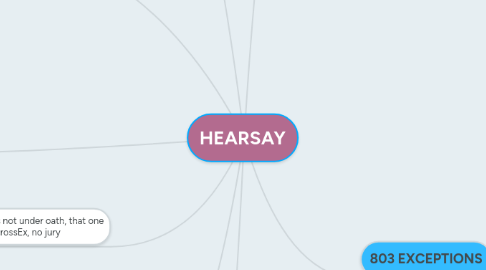
1. OCS/TMA
1.1. Statement: oral assertion, written assertion, nonverbal conduct if intended as an assertion
1.1.1. 1. Direct Assertion: She just ran the red light.
1.1.2. 2. Hidden Assertion: That freezer is cool.
1.1.3. 3. Hyperbolic Assertion: It was a million degrees outside.
1.1.4. 4. Indirect Assertion: No one pays attention to red lights anymore.
1.1.5. 5. Linked Assertion: answer linked to question.
1.1.6. 6. Vicarious Assertion: attributed to Declarant but said by someone else
1.1.7. 7. Implied
1.1.8. 8. Conduct as an Assertion
1.2. Declarant: means the person who made the statement
1.2.1. Must be human; no machines, animals, inanimate objects
1.3. Not TMA, not Hearsay (Other purposes:)
1.3.1. 1. Impeachment of a Witness: inconsistent statements and credibility
1.3.2. 2. Effect on the Hearer (but not for TMA)
1.3.3. 3. Verbal Acts --> Words of Independent Legal Significance: verbals Ks and Defamation
1.3.4. 4. Circumstantial Evidence of State of Mind, Memory or Belief of the Declarant (Belief, fear, knowledge/lack, criminal predisposition/lack, motive, notice
2. To prevent statements not under oath, that one is unable to refute or crossEx, no jury
3. Risks
3.1. 1. Perception / Misperception
3.2. 2. Recollection / Faulty Memory
3.3. 3. Narration / Ambiguity
3.4. 4. Sincerity / Insincerity
4. FRE
4.1. 801 Defines Hearsay
4.2. 802 Exclusions: Is it Hearsay?
4.2.1. if NO, then not inadmissible under 802
4.2.2. if YES, does an EXCEPTION apply?
4.2.3. if YES, then not inadmissible
4.2.4. if NO, then inadmissible
4.3. 803 1st category of EXCEPTIONS admitted whether Declarant is available to testify or not
4.4. 804 2nd category of EXCEPTIONS rec'g only if Declarant is unavailable
4.5. 805 Hearsay w/in Hearsay
4.6. 807 Residual Exception
5. Analysis
5.1. 1. Identify Declarant and Witness
5.2. 2. Was it a Statement?
5.3. 3. Out of Court?
5.4. 4. Direct Assertion?
5.5. 5. TMA?
6. 804 Unavailability
7. 801 EXCLUSIONS
7.1. 1. D/W's Prior Statements
7.1.1. Inconsistent w Declarant's testimony and given under oath
7.1.2. Consistent but offered to rebut or rehabilitate W
7.1.3. requires availability
7.2. 2. Opposing Party's Statements
7.2.1. 1. Individual or Representative Capacity
7.2.2. 2. Manifested Adopted Believed to be True (Express, Implied, Silence)
7.2.3. 3. Authorized speaker
7.2.4. 4. Agent / Employee, w/in Scope of Relationship while it Existed
7.2.5. 5. Party's Coconspirator during and in Furtherance of the Conspiracy
8. 803 EXCEPTIONS
8.1. 1. Present Sense Impression
8.1.1. 1. Stmt describing event
8.1.2. 2. Personally perceive event or condition
8.1.3. 3. Stmt during or immediately after event
8.2. 2. Excited Utterance
8.2.1. Elements
8.2.1.1. 1. Startling Occurrence
8.2.1.2. 2. While under stress or excitement
8.2.1.3. 3. Absence of time to fabricate
8.2.1.4. 4. Re circumstances of the occurrence
8.2.1.5. 5. D personally observes
8.2.2. Factors
8.2.2.1. Traumatic nature of event
8.2.2.2. Length of time btwn
8.2.2.3. Whether stmt in re a question
8.2.2.4. Whether D was participant or bystander
8.3. 3. Then-Existing Mental, Emotional or Physical Condition
8.3.1. Motive, Intent, Plan
8.3.2. Must be at same time
8.3.3. "I have a headache" NOT "Yesterday I had a headache"
8.3.4. Wills Exception: Stmts which refer to past matters are admissible if they relate to the execution, revocation, identification or terms of a D's will
8.4. 4. Statement Made for Medical Diagnosis or Treatment
8.4.1. 1. Purpose is med diagnosis or treatment
8.4.2. 2. Stmt must describe or relate to med history, past/present symptoms, pain, sensations, reasons
8.4.3. 3. Reasonably pertinent to diagnosis or treatment
8.5. 5. Recorded Recollection
8.5.1. 1. Personal knowledge
8.5.2. 2. W has insufficient recollection to testify fully and accurately
8.5.3. 3. Record made or adopted by W when matter as fresh in W's mind and so is accurate
8.5.4. 4. Memo or record is shown to reflect kn correctly
